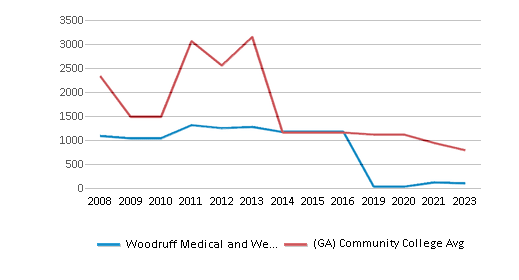- Le Cordon Bleu College of Culinary Arts-Atlanta college offers one of the most intensive, practical, and comprehensive culinary training programs. Our students can develop a focused, theoretical foundation and learn essential technical skills that can be applied to the finest culinary traditions, methods, and modern innovations. We offer two major programs: Le Cordon Bleu Culinary Arts and Le Cordon Bleu Pâtisserie and Baking. Programs begin several times a year. Our staff is available to assist you with financial aid options and help you pursue job opportunities as you approach graduation. Financial Aid is available for those who qualify.
School Highlights
Woodruff Medical and Wellness Training serves 169 students (49% of students are full-time).
The college's student:teacher ratio of 19:1 is higher than the state community college average of 18:1.
Minority enrollment is 97% of the student body (majority Black), which is more than the state average of 61%.
Quick Stats (2025)
- Enrollment: 169 students
- Private-state tuition: $13,395
- Student:teacher ratio: 19:1
- Minority enrollment: 97%
- Source: Integrated Postsecondary Education Data System (IPEDS)
Top Rankings
Woodruff Medical and Wellness Training ranks among the top 20% of public schools in Georgia for:
Category
Attribute
Completion Rates
School Overview
The teacher population of 9 teachers has stayed relatively flat over five years.
Woodruff Medical and Wellness Training
(GA) Community College Avg.
Carnegie Classification
Not applicable, not in Carnegie universe (not accredited or nondegree-granting)
Associates--Public Rural-serving Medium
Institution Level
Less than 2 years (below associate)
At least 2 but less than 4 years
Institution Control
Private for-profit
Public
Total Faculty
9 staff
209 staff

Number of Programs Offered
3
16
Student Body
The student population of Woodruff Medical and Wellness Training has grown by 201% over five years.
The student:teacher ratio of 19:1 has decreased from 20:1 over five years.
The Woodruff Medical and Wellness Training diversity score of 0.45 is less than the state average of 0.71. The school's diversity has stayed relatively flat over five years.
Total Enrollment
169 students
2,242 students

Student : Teacher Ratio
19:1
18:1

# Full-Time Students
82 students
882 students

# Part-Time Students
87 students
1,722 students



# Enrollment Undergraduate
169 students
299 students
# Full-Time Undergraduate Students
82 students
929 students

# Full-Time Graduate Students
n/a
87 students
# Part-Time Undergraduate Students
87 students
1,891 students
# Part-Time Graduate Students
n/a
53 students
Total Dormitory Capacity
n/a
654 students
% American Indian/Alaskan
1%
n/a
% Asian
3%
4%

% Hispanic
11%
10%

% Black
73%
35%

% White
3%
39%

% Hawaiian
2%
1%
% Two or more races
1%
3%

% Non Resident races
n/a
1%
% Unknown races
6%
7%


Diversity Score
0.45
0.71

College Completion Rate (Students who graduate in less than 4 years)
0.5852%
0.4279%

College Completion Rate (Students who graduate in 4 years or more than 4 years)
n/a
0.2368%
Average Graduate Earnings (10 Years)
$32,200
$29,500

Tuition and Acceptance Rate
The private state tuition of $13,395 is less than the state average of $15,267. The private state tuition has stayed relatively flat over four years.
Private State Tuition Fees
$13,395
$15,267

% Students Receiving Some Financial Aid
76%
93%

Median Debt for Graduates
$16,500
$12,000

Median Debt for Dropouts
$6,000
$5,500

Acceptance Rate
n/a
75%
SAT Reading
n/a
465
SAT Math
n/a
450
SAT Writing
n/a
465
ACT Composite
n/a
18
ACT English
n/a
18
ACT Math
n/a
18
ACT Writing
n/a
7
Source: 2023 (or latest year available) Integrated Postsecondary Education Data System (IPEDS)
Frequently Asked Questions
How much does Woodruff Medical and Wellness Training cost?
Woodruff Medical and Wellness Training's private state tuition is approximately $13,395.
What is Woodruff Medical and Wellness Training's ranking?
Woodruff Medical and Wellness Training ranks among the top 20% of community college in Georgia for: Average community college minority breakdown and Highest completion rates.
Recent Articles

How To Craft the Perfect College Admissions Essay
Read on to learn the ins and outs of crafting the perfect college application essay.

Obtaining Your Bachelor's Degree at a Community College
Explore the evolving landscape of community colleges offering bachelor's degrees, addressing affordability, accessibility, and workforce needs.

A to Z of Community College Certificates and Courses
From business and healthcare to technology and skilled trades, the article showcases the breadth of options available to students seeking to enhance their knowledge, develop new skills, or pursue career advancement.







